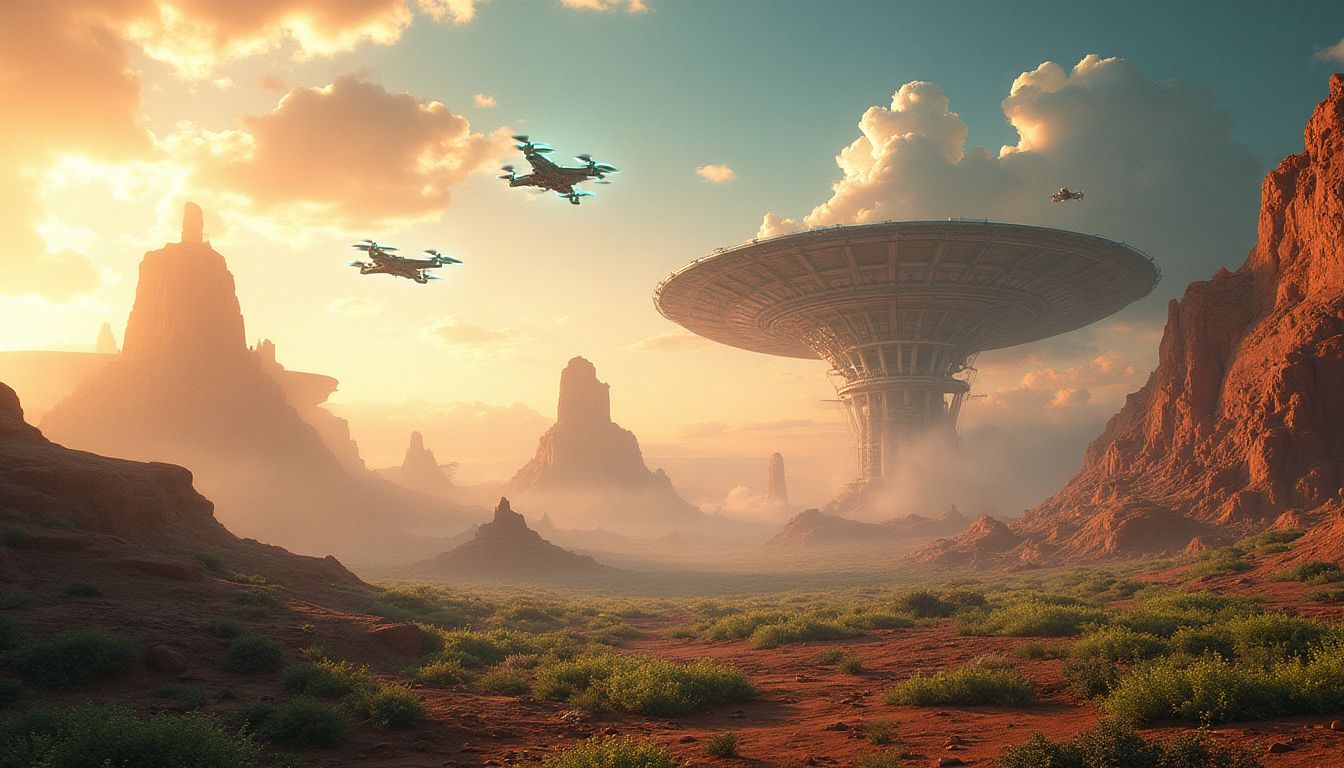Introduction: The Future Awaits
A journey of a thousand miles begins with a single step. - Lao Tzu. In this profound piece of wisdom, the Chinese philosopher reminds us that even the most daunting challenges start with a single action. Today, we stand on the brink of such a journey. Not just across continents, but across planets. The possibility of transforming Venus from an inhospitable furnace to a livable paradise may seem like a distant dream, yet this is the first step on that thousand-mile journey.
But what if artificial intelligence (AI), the marvel of modern technology, holds the key to this extraordinary quest? Could these intelligent systems transform this bright 'Morning Star' into a world where humanity could thrive? Carl Sagan, the visionary astronomer, once speculated on the possibility of terraforming Venus. Meanwhile, Stephen Hawking urged us to find new homes beyond Earth. Today, even Elon Musk, with his eyes set on the stars, suggests that our future may lie among the planets. As we venture into the cosmos, crafting a home on Venus could redefine our very existence.
In this space-faring adventure, AI emerges as our greatest ally. This article explores how AI's remarkable capabilities could unravel the mysteries of Venus, enabling us to transform it into a second Earth. Let's dive into this futuristic tale, where humanity's imagination meets the power of AI.
The Environment of Venus: A Planetary Enigma
Venus, Earth's closest planetary neighbor, is as mysterious as it is inhospitable. The planet is often shrouded in a thick veil of clouds, hiding a world of searing heat and extreme pressures. Its surface temperature soars to around 900°F (475°C), and the atmospheric pressure looms at an astonishing 92 times that of Earth. Picture diving to the ocean's depths while simultaneously baking inside an oven—that's the harsh reality of Venus.
The real head-scratcher for scientists and space enthusiasts alike is this: how can Venus, so similar in size and composition to Earth, be so drastically different? Its dense carbon dioxide atmosphere and sulfuric acid clouds, combined with a runaway greenhouse effect, make teraforming a herculean challenge. Yet, understanding these conditions is crucial for AI, which could become the puzzle solver in transforming this enigmatic world.
When it comes to unraveling Venus's secrets, AI can step in with capabilities we humans might only dream of. These synthetic minds can process vast datasets to map out the planet's geology, locate trapped water vapor in the clouds, and even identify mineral resources that remain tantalizingly out of reach. Consider them the ultimate planetary detectives, offering us clues from the confines of their algorithmic thinking.
Further unraveling the mysteries of Venus is less sci-fi and more of a practical puzzle, needing solutions that combine human ingenuity and AI's analytical might. These are not just idle musings; they are sparks of inspiration that could eventually lead humanity to have brunch under Venusian skies someday. Until then, our AI companions will continue to make some sense of this fiery riddle. Gather your courage and your curiosity, as the journey to decipher Venus is only getting started!
The Technology Landscape: Current State of Terraforming Technologies
In the race to transform celestial bodies like Venus into habitable zones, current technological capabilities are as fascinating as they are diverse. The sci-fi apparatuses we once read about in comic books now emerge as viable tools in humanity's toolbox. With advancements in robotics, nanotechnology, and more, we're no longer dreaming; we're planning.
Role of Drones and Robots
Enter the world of drones and robotic systems, the unsung heroes mapping out Venus' fiery terrain. These metallic maestros harness data in ways we couldn't imagine just decades ago. Using robotic systems for mapping and assessing hazards, they might as well be our interplanetary cartographers, trailing routes that keep future human inhabitants safe. Imagine a world where robots function not only as helpers but as pioneers of exploration!
Developments in Materials Science
The cutting-edge field of materials science is making waves, thanks to recent advancements that redefine what's possible. From solar harvesting technologies capable of sustaining life to adaptive materials that morph depending on environmental conditions, the blend of science and magic here feels very real indeed. Could our sun-drenched sisters and brothers on Venus soon flaunt nanowalls? It's not as far-fetched as it sounds!
AI’s Role in Terraforming: From Analysis to Application
Artificial intelligence, the tech world's wonderchild, parades onto the terraforming stage with aplomb. Gone are the days when AI acted primarily as a digital puppet. Today, it sits at the controls, steering terraforming efforts toward innovation.
Machine Learning Algorithms
The genius of AI lies in its algorithms, particularly those that spring to life through machine learning. These little intellects analyze climate patterns, predict atmospheric changes, and evaluate ecosystem viability with startling precision. Imagine, if you will, a digital clairvoyant, predicting shifts and sifting through potential solutions with the ease of a jazz pianist at their keys. Well-played, AI! Armed with these capabilities, the futuristic vision of inhabiting Venus becomes less fantasy and more blueprint.
AI-Driven Simulations
Simulating terraforming scenarios takes center stage in AI’s toolkit. AI-driven simulation models serve as the orchestration of potential scenarios, each model surfacing from the virtual void to ask, "What if?" Playing out terraforming stretches like scenes from an epic space opera, AI offers meticulous insights, allowing scientists to dive into data and emerge with informed decisions. It's as if Rosie from The Jetsons had a mind meld with a supercomputer. Oh, the places AI is taking us!
Biological Engineering: Creating Life on Venus
Imagine standing on a new Venus, teeming with life—life engineered to thrive where life never existed before. This might sound like science fiction, but thanks to biotechnology and synthetic biology, it is becoming a tangible possibility. To transform Venus into a habitable world, we must focus on the delicate balance of initiating new life forms, well-suited to its extreme environment.
Developments in Synthetic Biology
Synthetic biology could play a crucial role in designing extremophiles—organisms made for life's impossible scenarios. These are not your typical bacteria or fungi. They're engineered to cope with the sweltering heat and crushing pressure of Venus. It's like creating superheroes of the microbial world, tailored with precision to pave the way for future ecosystems. The magic lies in tweaking the DNA and reimagining life itself.
Genetically Engineered Microbes
This endeavor might involve reshaping our atmosphere's usual suspects: introducing genetically engineered microbes designed to convert the heavy carbon dioxide of Venus into oxygen and foster a breathable atmosphere. It sounds deceptively simple but involves a symphony of processes akin to orchestrating life itself. Imagine tiny architects building an Eden, molecule by molecule.
- Microbial conversion of CO2 into O2
- Elastic adaptation to temperature extremes
- Facilitating nutrient cycles to promote habitat formation
Ethical Considerations: The Philosophical Debate
Before we unleash young Earthlings onto Venus, let us pause to consider the ethics. Do we have the right to recreate another Earth, even if in the name of survival? Such questions invite a deep, profound contemplation—pit ethics against human curiosity, responsibility against ambition.
Risks of Contamination and Unintended Consequences
The stark reality is that introducing Earth life to Venus might risk crossing a new ecological frontier with unintended consequences. We must avoid contamination by Earth's microorganisms that might either perish outright or adapt to become cataclysmic anomalies on a distant world. Can we contain them effectively? Or will some runaway mutation derail our best efforts?
Evaluating the Rights of a Terraforming Venus
Finally, let us ponder: Does a terraformed Venus hold rights of its own? Are we, in a sense, creating a new sentient being—a planet deserving moral consideration? Perhaps we stand at a pivot point where core values blend into new philosophies and our colonial aspirations transform into undertakings of otherworldly stewardship. It is an unprecedented moral horizon, a new dawn of cosmic responsibility.
- Considering planetary rights and ethical obligations
- Balancing ecological integrity with exploration potential
- Envisioning sustainable cohabitation strategies
AI Solutions: Paving the Way to a New Planet
As we venture into the ambitious realm of terraforming Venus, AI emerges as an invaluable ally. Picture this: with its immense data-processing power, AI could analyze the complex atmospheric data collected from missions like the NASA Parker Solar Probe and historic spacecraft like the Soviet Venera probes. By identifying patterns and trends in the climate and surface conditions of Venus, AI could help develop tailored terraforming methodologies that optimize every breath, every moment of energy, and every inch of viable land on this planet.
Let’s break it down:
First, AI can perform a comprehensive analysis of Venus’s harsh conditions using existing data. This would harness machine learning to identify patterns in atmospheric phenomena, enabling researchers to make informed decisions based on accurate predictions of weather shifts and environmental changes.
Next, AI algorithms can engage in drilling through the vast number of potential terraforming models, testing thousands of simulations to find the most effective approaches. Imagine an AI system iteratively refining atmospheric processors crafted by AI-guided engineering teams. Such technologies could break down gases, creating vital hydrogen and oxygen while optimizing energy throughout the process.
Beyond simulations, AI can also lead the design and automation of drone swarms. These swarms, reminiscent of a flock of synchronized birds, could construct solar sails or reflectors designed to alter solar radiation absorption and manage Venus’s scorched surface temperatures. The adaptability of AI ensures these drones can learn from practical experiences, enhancing their original designs.
Through extensive modeling and continuous data feedback, AI systems will grow increasingly skilled at predicting potential hazards during long-term habitation. Picture an ever-so-watchful guardian ensuring our safety.
Actions Schedule/Roadmap:
The following is a structured roadmap designed for institutions, organizations, or governments aspiring to start terraforming Venus, structured similarly to the meticulous planning behind the Manhattan Project:
Day 1: Form an international consortium focusing on Venus terraformation. Engage scientists from renowned institutions like NASA, the European Space Agency, and private sectors such as SpaceX, comprising planetary scientists, robotics experts, ethicists, and climate modelers.
Day 3: Launch an existing data-gathering initiative to mobilize AI algorithms for synthesizing historical data from prior missions.
Week 1: Begin initial simulations assessing the impacts of potential terraforming actions on the atmosphere and surface conditions.
Week 2: Develop a detailed assessment report regarding Venus’s current environmental state, using AI-enhanced analysis to compile data on temperature, pressure, and atmospheric composition.
Week 3: Host a workshop focused on the ethical implications of terraforming, bringing together scientists, ethicists, and policymakers. Organizations like AAAS may contribute their expertise to ensure a balanced debate.
Month 1: Conduct lab tests simulating Venus-like conditions and assess potential biological candidates for adaptability. Collaborate with universities like MIT and Stanford to leverage their research capabilities.
Month 2: Prototype atmospheric processors and employ AI to run evaluations based on finite element analyses, ensuring designs are functional in Venus conditions.
Month 3: Commence drone swarm tests, utilizing simulations to develop controlled mapping of the Venusian surface to identify potential landing and construction sites.
Year 1: Formulate initial designs for orbiting solar reflectors. Add project management oversight from experienced leaders at organizations like NASA’s Jet Propulsion Laboratory.
Year 1.5: Collect and calibrate data from initial atmospheric processing tests. Evaluate gas cycles and ecosystem responses to adjustments made through simulated terraforming efforts.
Year 2: Initiate a pilot mission with robotic terraformers, carefully analyzing responses to life introduced in controlled environments on Venus. Team with robotics experts from Boston Dynamics to enhance automation and adaptability.
Conclusion: The Future Is Ours to Create
As we stand at this monumental crossroads, the union of AI advancements, engineering marvels, and biotechnological ingenuity offers a glimmer of hope. Terraforming Venus may transition from science fiction to achievable reality, allowing humans to breathe life into a once-barren world. The challenges are significant but not insurmountable; extraordinarily bright minds are already at work seeking solutions.
Our potential isn’t just rooted in survival but also in deriving the spirit of innovation that has propelled humanity forward for eons. Imagine creating a new ecosystem, one where life thrives in a place once thought inhospitable. It’s a vision that ignites our collective dreams and reflects our ingenuity. If we embrace this vision, not only can we shape a new destiny for Venus, but we can also redefine our relationship with the cosmos. So, let’s embark on this journey with open hearts and curious minds, cognizant of the implications, challenges, and opportunities that lay ahead.
What do you think about terraforming Venus? Are the technologies available today sufficient to realize such a dream? Join the conversation in the comments below!
FAQ
Q: Can Venus really be terraformed?
A: Yes, many scientists believe that while the challenges are huge because of Venus's harsh climate, technologies like artificial intelligence (AI) might help us create ways to change its environment step by step. The NASA space agency has even discussed some plans for making Venus more human-friendly.
Q: What technologies are currently available to assist in terraforming?
A: We have many exciting technologies that could help transform Venus! Here are a few:
- Artificial Intelligence (AI): AI can analyze data and help scientists understand how to change the atmosphere.
- Robotics: Robots can explore Venus safely, mapping its surface and finding resources to use.
- Biotechnology: Scientists can create special organisms that might be able to survive on Venus and make oxygen.
Q: What ethical concerns surround terraforming a planet?
A: As we think about terraforming, we must ask ourselves some important questions. Here are a few:
- Are we disrupting something unknown? We could hurt any current life forms, even microscopic ones.
- What rights would these new ecosystems have? If we create life on Venus, should we protect it like we protect life on Earth?
- Will Earth be affected? Any mistakes we make on Venus might have consequences back on our home planet.
Q: How long might it take to terraform Venus?
A: It's hard to say exactly how long it would take to make Venus more like Earth. Some experts think it could take decades, while others think it might take centuries or even longer! It all depends on how fast technology develops and how much effort the international community puts into the project, especially groups like ESA (the European Space Agency).
Q: What are the main challenges of terraforming Venus?
A: There are several major challenges we must overcome:
- Extreme Temperatures: Venus is super hot, reaching around 900°F (475°C).
- Heavy Atmosphere: The atmosphere is 92 times heavier than Earth's, so making it breathable is a big task.
- High Pressure: The pressure on Venus is like being thousands of feet underwater, making traditional exploration tough.
Q: What is the next step for scientists interested in terraforming Venus?
A: The next steps involve research and collaboration. Scientists and engineers from around the world, including teams from NASA's Jet Propulsion Laboratory, are already thinking about ways to gather data about Venus. They will look for resources, study the planet’s conditions, and even begin small experiments that could lead to larger terraforming plans.
Q: Are there any missions planned for Venus exploration?
A: Yes! Future missions, like the NASA's VERITAS mission and the DAVINCI+ mission, aim to study Venus closely. These missions will help us gather important data essential for our understanding of the planet.
Q: What do scientists think Venus looked like in the past?
A: It's believed that, billions of years ago, Venus may have had water on its surface and could have supported life. Scientists are eager to learn more about its past to see how and why it changed. This knowledge could guide us in our terraforming efforts.
Wait! There's more...check out our gripping short story that continues the journey: The Reclamation of Humanity
Disclaimer: This article may contain affiliate links. If you click on these links and make a purchase, we may receive a commission at no additional cost to you. Our recommendations and reviews are always independent and objective, aiming to provide you with the best information and resources.
Get Exclusive Stories, Photos, Art & Offers - Subscribe Today!





























1 comment